Zalman ZM750-EBT PSU Review
Zalman's new EBT line consists of four PSUs ranging from 650W to 1kW capacity. Today, we're testing the ZM750-EBT, which, thanks to a low price, achieves a good value score. But how does it fare in terms of absolute performance?
Why you can trust Tom's Hardware
A Look Inside And Component Analysis
Parts Description
Before proceeding with this page, we strongly encourage you to a look at our PSUs 101 article, which provides valuable information about PSUs and their operation, allowing you to better understand the components we're about to discuss. Our main tools for disassembling PSUs are a Thermaltronics soldering and rework station, and a Hakko 808 desoldering gun.
| Primary Side | |
|---|---|
| Transient Filter | 4x Y caps, 2x X caps, 2x CM chokes, 1x MOV, 1x CMD02X |
| Inrush Protection | - |
| Bridge Rectifier(s) | 1x |
| APFC MOSFETs | 2x Infineon IPP50R140CP (550V, 15A @ 100 °C, 0.14 ohm ) |
| APFC Boost Diode | 1x CREE C3D08060A (600V, 8A @ 152 °C) |
| Hold-up Cap(s) | 1x Nippon Chemi-Con (400V, 470uF, 2000h @ 105 °C, KMQ) |
| Main Switchers | 2x Infineon IPA50R190CE (550V, 11.7A @ 100 °C, 0.19 ohm) |
| APFC Controller | Infineon ICE3PCS01 |
| Switching Controller | Infineon ICE2HS01G |
| Topology | Primary side: Half-bridge and LLC Resonant Converter Secondary side: Synchronous Rectification & DC-DC converters |
| Secondary Side | |
| +12V MOSFETs | 4x IRFB743PbF (40V, 180A @ 100 °C, 2.0 milliohm) |
| 5V & 3.3V | DC-DC Converters: 8x Infineon IPD060N03L G (30V, 50A @ 100 °C, 6 milliohm) PWM Controller: Anpec APW7159 |
| Filtering Capacitors | Electrolytics: Teapo (105°C) Polymers: Teapo |
| Supervisor IC | SITI PS223 (OVP, UVP, OCP, SCP, OTP) |
| Fan Model | Globe Fan RL4Z S1352512H (135mm, 12V, 0.33A, 1550 RPM, Fluid Dynamic Bearing) |
| 5VSB Circuit | |
| Standby PWM Controller | Sanken STR-A6069H |




The ZM750-EBT is based on Sirfa's HPM platform; we recently saw it in SilverStone's unimpressive ST75F-GS V2. The PCB could easily be housed in a smaller chassis, which would reduce the PSU's depth. Nevertheless, the architecture is modern. On the primary side, a half-bridge topology is used along with an LLC resonant converter for increased efficiency. In the secondary side, Sirfa employs a synchronous design, meaning that FETs regulate the +12V rail; the minor rails are generated by two DC-DC converters. Overall, the cap choice is decent for a mainstream PSU (Teapo caps are reliable, and besides electrolytic caps, we also found a significant number of Teapo's polymer caps). Finally, heat sinks on the primary and secondary sides are ample, especially for a Gold-rated PSU that offers lower energy losses compared to less efficient supplies.




The transient filter starts at the AC receptacle with one X and two Y caps. On the X cap, we spotted a CMD02X that blocks current through the cap's discharge resistor when AC voltage is connected, improving efficiency. The same filter continues on the main PCB with another X cap and two Y ones, along with two CM chokes and a small MOV installed after the bridge rectifier.
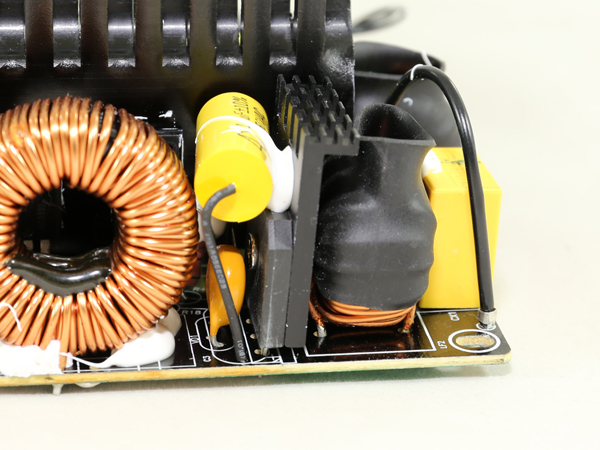
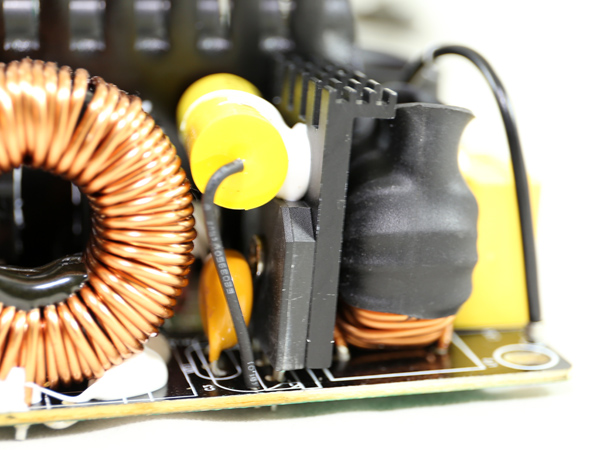
The single bridge rectifier is bolted on a dedicated heat sink. Usually, higher bridge rectifier temperatures translate to less energy loss on its diodes, since voltage drops on diodes decrease at higher temperatures. However, like all electronic parts, if you want to keep the bridge rectifier healthy, you have to cool it down effectively.



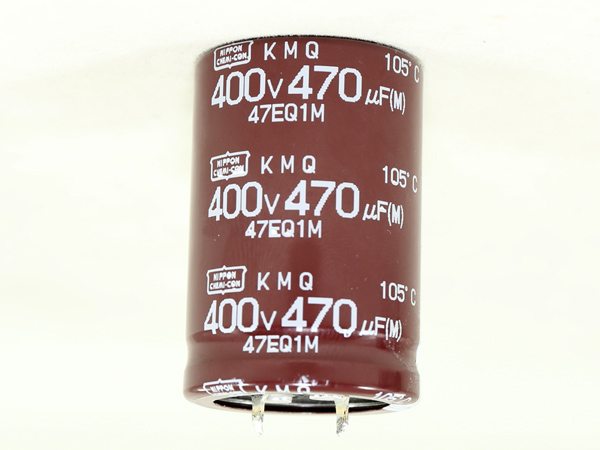

A single CREE C3D08060A boost diode is used in the APFC converter, along with a couple of Infineon IPP50R140CP FETs. The bulk cap is provided by Nippon Chemi-Con (400V, 470uF, 2000h @ 105 °C, KMQ) and its capacity is very low for a 750W PSU. The SilverStone ST75F-GS V2, which uses the exact same platform, has a larger bulk cap and still failed to reach a 17ms hold-up time. Lastly, the PFC controller is installed on the solder side of the PCB; it's an Infineon ICE3PCS01 IC.



The main switchers are a couple of Infineon IPA50R190CE FETs, arranged into a half-bridge topology. The LLC resonant controller is Infineon ICE2HS01G IC, which is installed on a vertical daughterboard.



In the secondary side, four International Rectifier IRFB743PbF FETs regulate the +12V rail. They're installed on an ample heat sink, at least compared to other Gold-rated PSUs, so we wonder why Sirfa didn't arm this supply with a semi-passive mode. On the same heat sink, we also found the NTC thermistor that provides temperature data to the fan controller, and most likely to the over-temperature protection circuit.
Get Tom's Hardware's best news and in-depth reviews, straight to your inbox.




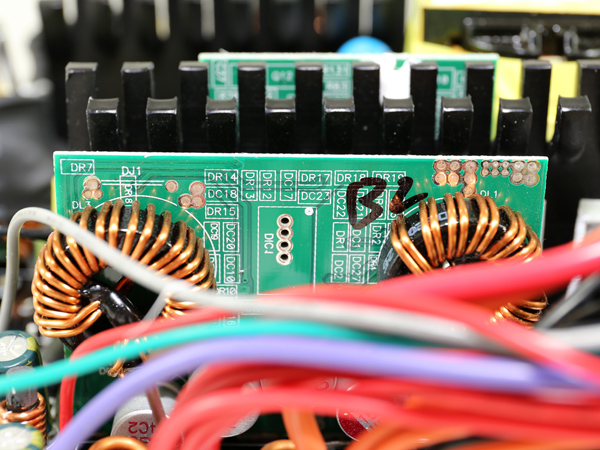
A large vertical PCB houses the DC-DC converters responsible for the minor rails. The common PWM controller is an Anpec APW7159 IC. Eight Infineon IPD060N03L G FETs are used by both converters. Several Teapo polymer caps provide ripple filtering services to the DC-DC converters.


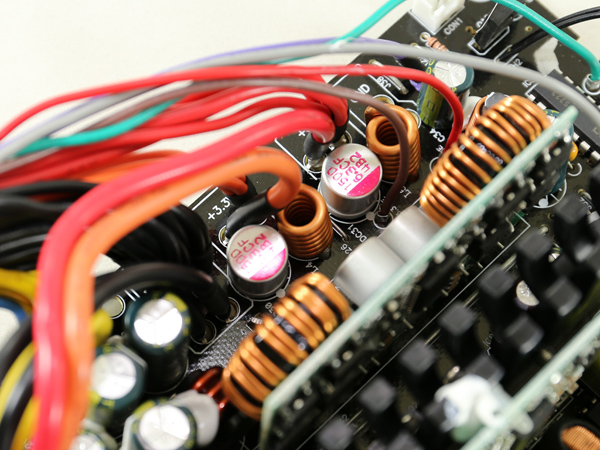
In the secondary side, the polymer and electrolytic filtering caps are provided by Teapo. All electrolytic capacitors are rated at 105 °C, so their useful life should be long, even under stressful conditions. According to Zalman the new batches will feature only Japanese filtering capacitors, to accommodate the extension of the provided warranty from five years to seven.




Sirfa didn't install any filtering caps on the modular PCB, although there is plenty of space for them. That's a shame, since additional caps would offer better ripple suppression (something this platform needs).


The standby PWM controller is a Sanken A6069H, and housekeeping is handled by a SITI PS223 IC. Aside from the basic protection features, it also supports over-temperature and over-current protection. The PS223 can actually provide OCP for up to two +12V rails, though this PSU only has one.







Soldering quality on the main PCB is good. On the secondary side, Sirfa uses a couple of large copper bars to enhance the conductivity of the earth and +12V paths. Moreover, we noticed two shunt resistors under the +12V islands. Given the PS223's two-channel OCP, it appears evident that this PSU initially had a pair of +12V rails. Sirfa likely set the OCP triggering point very high to make it a one-rail design, since the shunt resistors aren't shorted together.
The fan's sticker claims that this is a fluid dynamic bearing fan but according to its model number, it's a plain sleeve bearing design. Someone is either using a nasty marketing trick or changes were made internally without a corresponding nomenclature update. In any case, we didn't want to destroy the fan to find out but thankfully Zalman did and proved that the fan indeed uses a Fluid Dynamic Bearing. Lastly, the fan profile is pretty aggressive, especially at high operating temperatures.
Current page: A Look Inside And Component Analysis
Prev Page Packaging, Contents, Exterior And Cabling Next Page Load Regulation, Hold-Up Time And Inrush Current
Aris Mpitziopoulos is a contributing editor at Tom's Hardware, covering PSUs.
-
Onus Although the article does mention safety, a very valid point, it still managed to imply that a single-rail PSU was "better" due to the complexity of managing rail assignments so as to not trip OCP protections. I've have not seen a multi-rail PSU actually get dinged for this in a review for maybe 8-10 years; it seems that everyone does OCP "right," so this is no longer an issue, ever. That being the case, the greater safety of a multi-rail design is superior.Reply
I'll need to make at least another pass through this article, but failing on +5V ripple under heavy load probably makes this a solid tier-3 unit; I'm not going to run screaming if I see one, but I wouldn't buy it either. -
JQB45 Tier-3 might be generous. There were a lot of cons. What good is a 7 year warranty if the PSU takes something else out in addition to the PSU.Reply
CONS: Ripple • Noisy under stress • Hold-up time • Inrush current • Sleeve-bearing fan • Single EPS connector • Inaccurate PWR_OK signal
Also it must also be strongly pointed out that this unit does not meet ATX specifications. -
Onus True, but the tier-3 units are the ones considered solid for lighter loads. Those cons are why I certainly would not buy one for a gaming or rendering rig, but for the typical PC that may not need even half this power, I wouldn't worry about it.Reply -
Sakkura The fact that it's not just barely breaking the ATX spec at 100% load, but already starts to go out of spec at 80% and then has two rails well out of spec at 100%, is what makes this a tier 4 unit, and a clear "do not buy" regardless of price.Reply -
yyk71200 One would expect that a gold rated powersupply would be at least a solid unit and a safe buy. Guess not. Shouldn't buy one simply based on advertised efficiency rating.Reply -
Onus That's definitely true. Coolermaster taught that lesson quite well.Reply
Hmmm, this one does seem a little worse than I thought at first. Any chance this particular unit had a problem? I'd think ripple could be fixed with a minor capacitor improvement, without adding too much to the price. Hopefully Zalman is paying attention. -
JQB45 Reply17328110 said:That's definitely true. Coolermaster taught that lesson quite well.
Hmmm, this one does seem a little worse than I thought at first. Any chance this particular unit had a problem? I'd think ripple could be fixed with a minor capacitor improvement, without adding too much to the price. Hopefully Zalman is paying attention.
agreed -
COLGeek It is interesting to see Zalman developing this line of PSUs. Hopefully, they will be better than previous generations. Had a couple Zalman PSUs a few years ago, when I used to use Zalman heatsinks.Reply
One died days after the warranty expired and the other about a month after. I'll give Zalman credit, they made right by me by exchanging both, but it was a painful process.
While I would not recommend these current products, I can at least "tolerate" them in budget builds. -
turkey3_scratch I would think anything out of spec should be Tier 4. Ripple is trash. 3.3V rail was on the brink of being out of spec. 12V was also quite terrible at 90mv.Reply
Anyway, I like your power supply reviews, Toms. You go more in-depth than any review site for power supplies (Hardwaresecrets, Johnnyguru). -
Sakkura Reply17328110 said:That's definitely true. Coolermaster taught that lesson quite well.
Hmmm, this one does seem a little worse than I thought at first. Any chance this particular unit had a problem? I'd think ripple could be fixed with a minor capacitor improvement, without adding too much to the price. Hopefully Zalman is paying attention.
Considering the same platform performs decently in the Silverstone unit, there's at least some hope that Zalman can go back, adjust a few things, and get a decent budget unit out of this.
Edit: I went back and looked at the Silverstone review. Ripple suppression was really good up to 90% load, then the 5V and 3.3V rails jumped hugely, especially the 3.3V. They did stay within ATX spec, but just barely. The 5V ripple went from 13.1mV at 90% to 40.5mV at 100%, 3.3V ripple went from 14.1mV at 90% to 49.9mV at 100%. Obviously the 3.3V ripple went out of spec at 110% load, as well as one of the crossloads, but that's a lesser sin.
